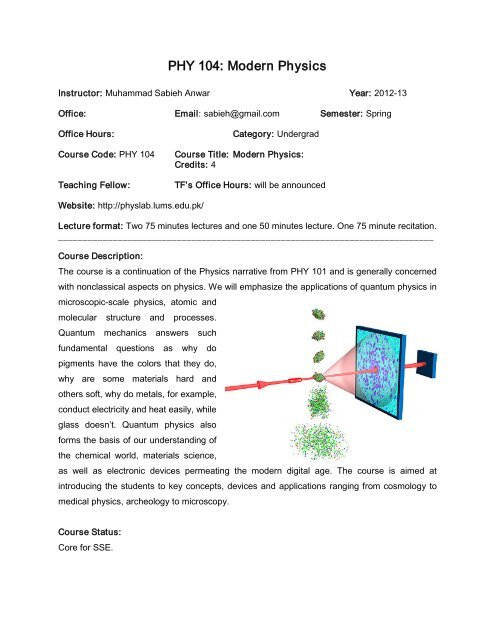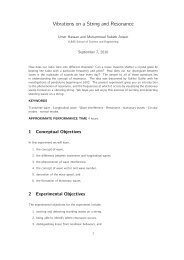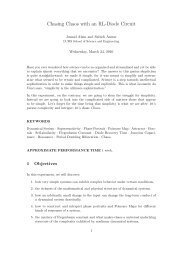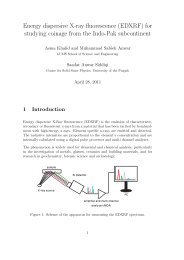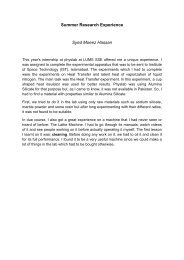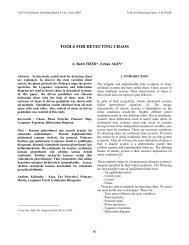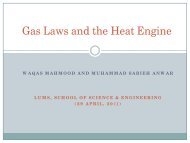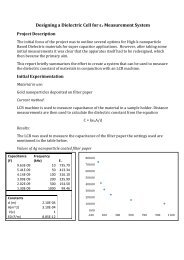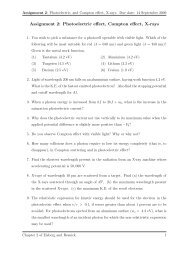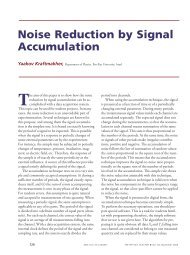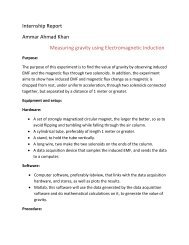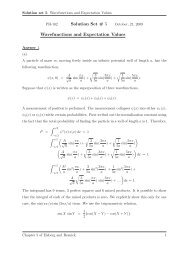Course outline
Course outline
Course outline
You also want an ePaper? Increase the reach of your titles
YUMPU automatically turns print PDFs into web optimized ePapers that Google loves.
Pre-requisites:PHY 101: MechanicsText books:Modern Physics by R. A. Serway, C.J. Moses and C.A. MoyerPhysics for Scientists and Engineers by Fishbane, Thornton and GasiorowizcGrading scheme:Quizzes 20%Homeworks: 10%Mid-Term 30%Final Exam 40%The instructor has the liberty of varying these grade assignments by 5%.Tentative <strong>Course</strong> Schedule & Topics:Week Topic Some ParticularApplications1-2 Molecular basis of thermodynamics: continuingfrom the last part of the course PHY101, theselectures will build upon the statistical foundations ofthermal physics, will end with blackbody radiationThis is an applied introductionto statistical physics andthermodynamics, rusting,osmosis, thermodynamics ofevolution3A Motivation for nonclassical physics: Double-slitintereference captures all, or most, of quantumInterfering bacteria and buckyballsphysics;3B Light is grainy: Photoelectric effect; Compton effect;X-raysDoes gravity effect light?Solar cells.4 But can light also be a wave: wave-particle duality;wavegroups and dispersion; uncertainty principleX-ray diffraction reveals thestructure of crystals includingDNA; Construction andworking of an electronmicroscope5 Light comes from atoms, so what are atoms Electrolysis; Spectroscopy:
composed of? Contributions of Faraday (atoms, looking at starsmolecules, charges exist), Thomson (electrons exist),Rutherford (nucleus exists) and Bohr (electrons arebound to orbits)6 Quantum Mechanics in One Dimension:Charge-couple devices (CCD)Wavefunction; free particle; particle in a box7 Tunneling: Finite square well, Tunneling α decay; decay of black holes;scanning tunnelingmicroscope8 Review and Mid-Term9-10 Quantum Mechanics in Three Dimensions: TheHydrogen atom, orbitals, angular momentum and itsquantization11 Angular Momentum and Magnetism: orbitalmagnetism, Zeeman effect, concept of spin, Pauli’sexclusion principleBuilding of the periodic table;magnetic resonance and MRI;why is iron magnetic? Whitedwarfs, and neutron stars12 How do atoms build molecules? Ionic bonds;covalent bonds; hydrogen bonds; molecular orbitals13 How do atoms build solids and stars? How arecrystals different from amorphous solids? Why andhow do metals conduct electricity? Bands in solids;Semiconductors.14 Nuclear Structure: Size and structure of nucleus;nuclear forces; radioactivity and nuclear reactions15 Review and Final ExamRaman spectroscopy;grapheneLight emitting diodes; lasers;superconductors, black holes,white dwarfs and neutronstarsDetermining the age of theearth; Radiation therapy


